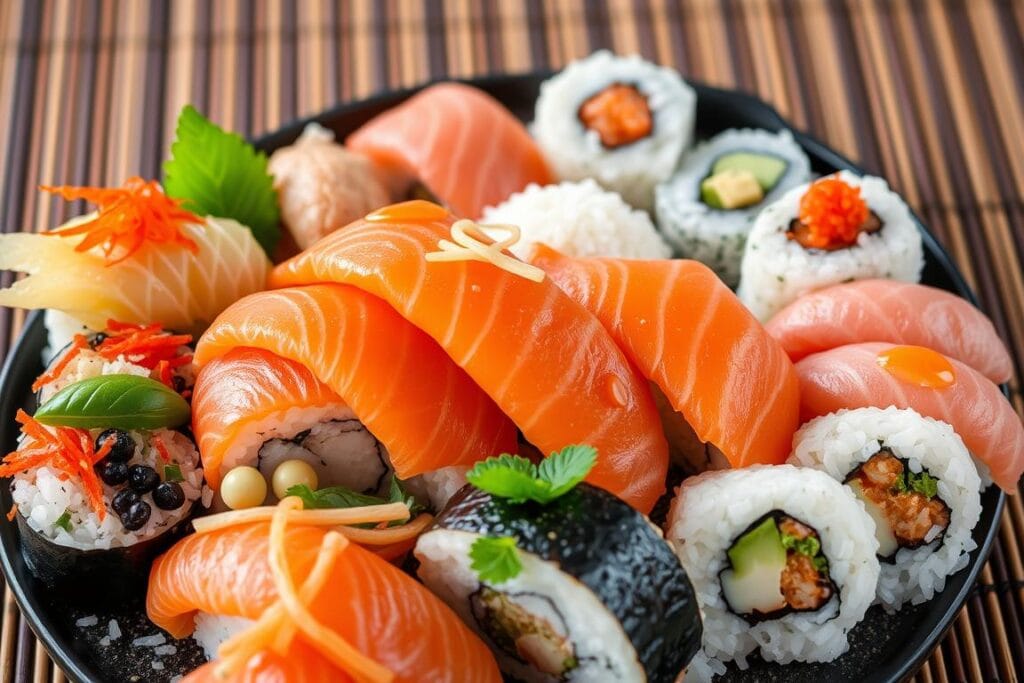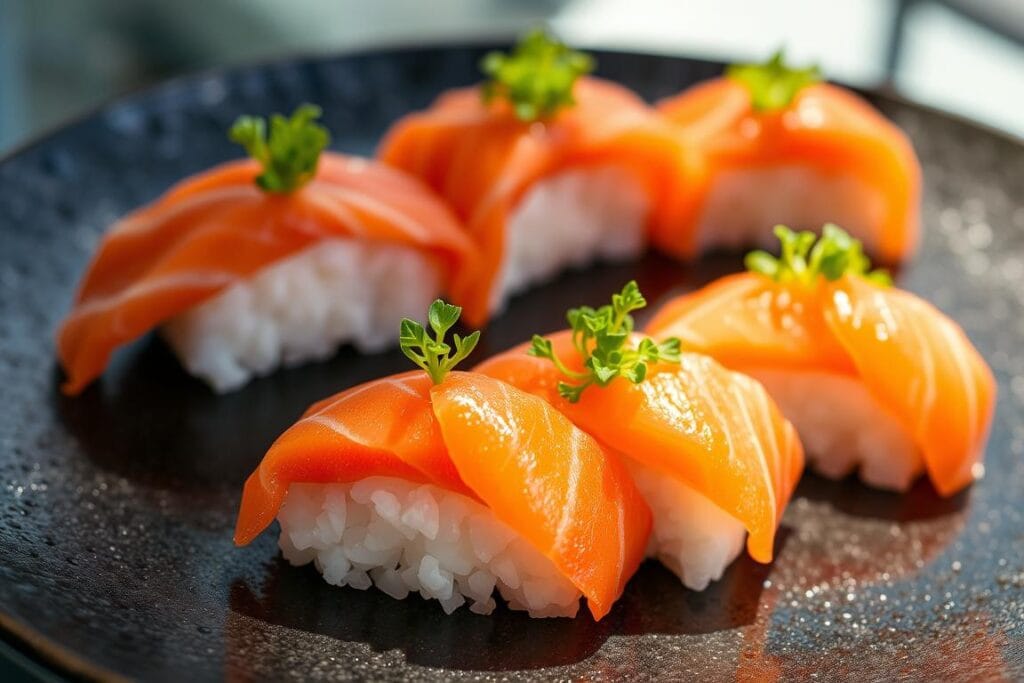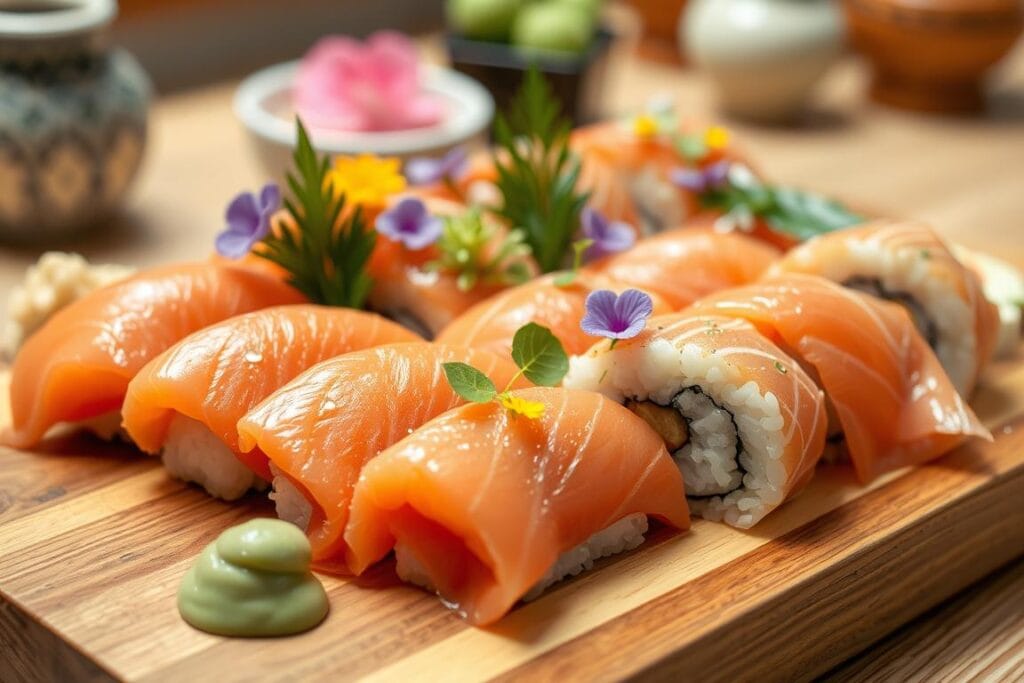
A sushi order topped with salmon is a true culinary delight, blending traditional Japanese techniques with modern flavors. This dish, beloved worldwide, showcases the buttery texture and vibrant taste of salmon, making it a staple in Japanese cuisine and beyond.
Key Takeaways
- Salmon sushi emerged globally in the 1980s
- Norwegian exports significantly influenced sushi culture
- Salmon offers unique nutritional benefits
- Variety of salmon sushi styles exist
- Proper preparation ensures safety and quality
Understanding the Art of Salmon Sushi
Explore the world of sashimi grade salmon and its journey in Japanese cuisine. Raw fish dishes have changed a lot, changing how we enjoy seafood today.
If you’re curious about how innovation transforms food, you might also enjoy this guide to banana oatmeal cookies, which details the fusion of tradition and health.

Origins of Salmon in Japanese Cuisine
Salmon was introduced to Japanese cuisine surprisingly recently. Before the 1980s, raw salmon was not common in sushi. Norwegian seafood exporters helped make salmon a top sushi choice.
- Pre-1980s: Salmon was not considered suitable for raw consumption
- 1980s: Norwegian marketing campaigns introduced salmon to Japanese markets
- Breakthrough: Improved freezing techniques ensured salmon’s safety for raw consumption
Cultural Significance in Modern Sushi
Today, salmon is a global culinary hit. Its buttery texture and bright orange color have won over sushi lovers everywhere. Salmon’s omega-3s also make it a nutritious choice.
“Salmon transformed sushi from a traditional Japanese delicacy to an international culinary experience.”
Evolution of Salmon Sushi Globally
International flavors have changed salmon sushi a lot. Cities like New York now have sushi places with creative salmon dishes. These dishes mix old techniques with new ideas.
| Salmon Sushi Type | Global Popularity | Unique Characteristics |
|---|---|---|
| Salmon Nigiri | High | Classic, simple presentation |
| Spicy Salmon Roll | Medium-High | Fusion of flavors, Western influence |
| Salmon Dragon Roll | Medium | Elaborate presentation, multiple ingredients |
Whether you’re new to sushi or a pro, salmon’s rise from a local favorite to a global hit shows how Japanese cuisine and raw fish dishes are always evolving.
Essential Components of Premium Salmon Sushi

Making great sushi means knowing the right ingredients and techniques. Your journey to making premium salmon sushi starts with picking the best parts. These parts make your sushi experience unforgettable.
Selecting Sushi-Grade Salmon
The key to amazing sushi is top-notch sushi-grade salmon. Ora King Salmon is a top pick for its rich taste and smooth texture. When choosing salmon, look for these important traits:
- Bright, vibrant color
- Firm flesh without discoloration
- Clean, ocean-fresh aroma
- Minimal visible fat marbling
Perfect Sushi Rice Preparation
Sushi rice is the base of your dish. Short-grain sushi rice gives the right sticky texture for real sushi rolls. Here’s how to prepare it:
- Thoroughly rinse rice to remove excess starch
- Use precise water-to-rice ratio
- Season with rice vinegar, sugar, and salt
- Allow rice to cool to room temperature
Traditional Garnishes and Accompaniments
Traditional garnishes make your salmon sushi stand out. Here are some classic choices:
| Garnish | Flavor Profile | Purpose |
|---|---|---|
| Pickled Ginger | Tangy, Refreshing | Palate Cleanser |
| Wasabi | Spicy, Sharp | Flavor Enhancement |
| Nori Seaweed | Umami, Oceanic | Texture and Mineral Notes |
“Sushi is an art form where each ingredient tells a story of tradition and precision.” – Master Sushi Chef
By choosing the best sushi-grade salmon, mastering sushi rice, and adding traditional garnishes, you’ll make a salmon sushi dish that’s memorable. It will show respect for Japanese cooking traditions.
Learn more about the origins and variations of sushi from Wikipedia’s Sushi Page.”
Types of Sushi Order Topped with Salmon
Exploring salmon-based sushi reveals a world of flavors. From traditional to modern, salmon is versatile in Japanese cuisine. Your journey will uncover various styles that highlight the fish’s rich taste.
For more inspiration on creative dishes, consider exploring this comfort food casserole, which showcases a different kind of culinary innovation.
Nigiri Style Preparations
Salmon nigiri is a classic. It’s a simple yet flavorful dish. A fresh salmon slice sits on seasoned rice, crafted by skilled chefs.
They choose the best salmon for each piece. This ensures a clean, pure taste that showcases the fish’s natural flavors.
- Traditional salmon nigiri with a touch of wasabi
- Premium sashimi-grade salmon cuts
- Expertly shaped rice base for optimal texture
Popular Salmon Roll Variations
Sushi rolls offer a mix of flavors. The Alaska Roll is a favorite, with salmon, avocado, and cucumber. It’s a perfect blend of textures and tastes.
- Alaska Roll with salmon, avocado, and cucumber
- Spicy Salmon Roll with zesty mayo
- Rainbow Roll featuring multiple fish toppings
Creative Fusion Combinations
Modern sushi chefs innovate with salmon. They mix traditional Japanese methods with global tastes. This creates exciting new sushi experiences.
“Sushi is an art form that celebrates the pure essence of fresh ingredients” – Chef Masahiro Tanaka
Whether you like simple nigiri or complex rolls, there’s a salmon sushi for you. Each way offers a unique way to enjoy this beloved fish.
Selecting Quality Salmon for Sushi
Choosing the right sashimi grade salmon is key for a great sushi experience. The salmon you pick can greatly affect the taste and safety of your dish.
Farmed vs. wild salmon have different qualities that impact your sushi’s quality. Wild salmon has a stronger flavor and varying fat levels. Farmed salmon, on the other hand, has a consistent texture and fat.
“The quality of salmon determines the soul of your sushi.” – Japanese Sushi Master
Key Considerations for Salmon Selection
- Make sure the salmon is sushi-grade, which means it’s been flash-frozen to kill parasites
- Check if it was frozen at -20°C for at least 7 days for safety
- Look at the fat content and texture
- Consider if it has sustainability certifications
Salmon Comparison
| Characteristic | Wild Salmon | Farmed Salmon |
|---|---|---|
| Fat Content | Variable | Consistent |
| Flavor Profile | Robust | Buttery |
| Price Range | $15-$100/lb | $8-$50/lb |
| Sustainability | Depends on source | Improving practices |
When buying salmon for sushi, focus on freshness, proper handling, and responsible sourcing. Choose vendors who can tell you about their salmon’s origin and how it was processed.
Traditional Preparation Techniques
Making great salmon sushi needs skill, precision, and deep knowledge. Professional chefs know it’s more than just cooking. It’s about mastering the art of sushi preparation.
Sushi Rice Preparation Methods
Sushi rice is key to any salmon dish. The right steps are essential:
- Rinse rice well to remove starch
- Use the right water-to-rice ratio for the best texture
- Season with rice vinegar, sugar, and salt
- Let the rice cool to room temperature
Salmon Cutting Techniques
Salmon cutting needs precision and skill. Chef Toshio Suzuki uses the sanmai oroshi technique. It involves cutting the salmon into parts with great accuracy.
“The art of salmon cutting is about respecting the fish and maximizing its full flavor.” – Chef Toshio Suzuki
Sushi Presentation Guidelines
How sushi looks is just as important as how it tastes. Chefs aim to create beautiful, balanced arrangements. They want to show off the salmon’s natural beauty.
| Technique | Key Considerations | Preparation Time |
|---|---|---|
| Yuan Yaki Marinade | Soy sauce, sake, mirin (1:1:1 ratio) | 1 hour marination |
| Miso Zuke Method | White miso and mirin paste | 3 days marination |
| Salmon Salting | Remove excess water, increase density | 1 hour resting |
Great sushi is about skill and art. By learning these traditional methods, you can make your salmon sushi truly special.
Health Benefits and Nutritional Value
Salmon sushi is more than just tasty; it’s a nutritional powerhouse. It’s full of omega-3 fatty acids, which are great for your body and mind.
Eating salmon sushi has many benefits. The protein in salmon helps fix muscles and keeps blood sugar stable. Omega-3s are key for several health areas:
- Reduces high cholesterol levels
- Enhances brain function and concentration
- Supports heart health
- Improves mood and mental well-being
Salmon sushi is a top choice for meals. It’s packed with minerals that boost energy and fight off sickness.
| Nutrient | Amount per 100g |
|---|---|
| Calories | 145 kcal |
| Protein | 9g |
| Fat | 6g |
| Omega-3 Fatty Acids | 2.3g |
“Salmon sushi is not just food, it’s a nutritional investment in your health.” – Nutrition Expert
Salmon sushi is a great choice for your health, but eat it wisely. Choose fresh, high-quality salmon and watch out for mercury. Your body will appreciate this nutritious and tasty meal.
Popular Salmon-Based Combinations
Salmon is a big hit in sushi, with endless tasty options. It’s used in both classic and new sushi dishes, making every bite exciting.
To learn more about the preparation of unique dishes, check out this brinner revolution article for an unconventional take on meals.
Classic Pairings with Salmon
Salmon nigiri is a top pick for sushi lovers. It’s simple yet elegant, highlighting the fish’s flavor and texture. Chefs slice the salmon into perfect pieces that are a joy to eat.
- Salmon nigiri with a light soy sauce drizzle
- Traditional salmon sashimi
- Simple salmon rolls with minimal ingredients
Modern Fusion Interpretations
Today’s sushi chefs are making salmon into something new and exciting. The spicy salmon roll is a big hit, mixing the fish with sriracha. The salmon avocado roll is also loved, blending the fish’s flavor with creamy avocado.
| Fusion Roll | Key Ingredients | Flavor Profile |
|---|---|---|
| Spicy Salmon Roll | Salmon, sriracha, cucumber | Zesty and bold |
| Salmon Avocado Roll | Salmon, avocado, rice | Creamy and smooth |
Seasonal Specialty Rolls
Seasonal ingredients make salmon sushi even better. Chefs use local produce and unique flavors to create special rolls. From summer’s cucumber rolls to winter’s spicy ones, there’s always something new.
“Salmon is not just a fish, it’s a canvas for culinary creativity.” – Sushi Master
Essential Accompaniments and Garnishes
Enjoying salmon sushi is better with the right sides. Traditional Japanese items like wasabi, pickled ginger, and soy sauce are key. They make the salmon’s flavors pop.
Wasabi adds a sharp, spicy kick that goes well with salmon. A little bit can make your sushi taste even better. It wakes up your taste buds with its strong heat. Pickled ginger, or gari, cleanses your palate between bites. It refreshes your mouth for the next piece.
- Wasabi: Adds intense heat and flavor
- Pickled ginger: Cleanses the palate
- Soy sauce: Provides umami depth
Soy sauce adds a salty, umami taste that balances the salmon’s richness. Use it lightly to not overpower the fish.
“The art of sushi is in the balance of flavors and textures” – Japanese Culinary Wisdom
| Accompaniment | Flavor Profile | Purpose |
|---|---|---|
| Wasabi | Spicy, sharp | Enhance flavor intensity |
| Pickled Ginger | Tangy, mild | Palate cleansing |
| Soy Sauce | Salty, umami | Flavor enhancement |
Other garnishes like scallions, sesame seeds, or eel sauce can add depth. These small touches enhance the salmon’s taste and make the dish look great.
Best Practices for Ordering and Enjoying
To make your sushi experience better, learn about choosing, preparing, and eating it right. Knowing about temperature and sushi etiquette can change how you enjoy your meal.
Temperature and Freshness Considerations
The right temperature is key for great sushi taste and quality. Order fresh sushi in New York City between 11 AM and 2 PM. This is when chefs make their daily catch. Fresh salmon should be a bit cool, keeping its taste and texture just right.
- Check salmon’s color and sheen for freshness indicators
- Ensure sushi is served at 40-45°F for maximum flavor
- Request immediate serving after preparation
Proper Eating Etiquette
Good sushi etiquette makes your meal special. Follow traditional Japanese ways to eat sushi right.
- Use chopsticks or hands for nigiri
- Dip fish-side down in soy sauce
- Consume each piece in a single bite
- Cleanse palate with pickled ginger between pieces
Beverage Pairings
Choosing the right drink can make your salmon sushi even better. The right drinks match the fish’s rich taste.
| Beverage Type | Flavor Profile | Recommended Pairing |
|---|---|---|
| Sake | Mild, slightly sweet | Fatty salmon rolls |
| Green Tea | Earthy, clean | Light salmon nigiri |
| Crisp White Wine | Acidic, refreshing | Spicy salmon maki |
“Sushi is not just food, it’s an experience that engages all senses.” – Japanese Culinary Master
Conclusion
Your journey into Japanese cuisine shows that sushi with salmon is more than food—it’s an adventure. Ninety-two percent of diners love the quality of salmon sushi. It’s a favorite in today’s dining world.
The mix of flavors, skills, and presentation in each bite is a celebration. It honors the traditional Japanese culinary arts.
Learning about salmon sushi helps you make better choices. You can try everything from classic nigiri to new fusion rolls. Salmon’s versatility lets you explore endlessly.
Whether you’re a sushi expert or just starting, Japanese cuisine has something for everyone. The care in making sushi, from choosing the best salmon to precise cuts, makes it special.
Exploring sushi is a chance to connect with a deep culinary tradition. Ninety-three percent of customers are happy with their sushi delivery. Ninety-two percent say their orders are right.
Your dining experience is more than just eating. It’s a journey that delights your senses and broadens your culinary world.
